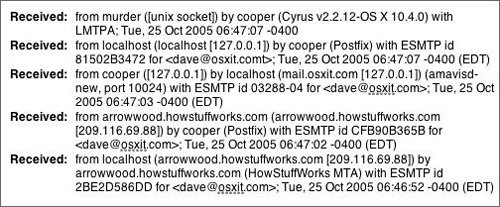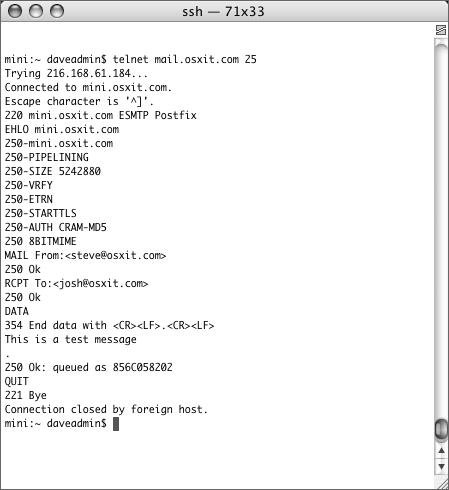Troubleshooting Mail
| Although mail protocols are one of the oldest on the Internet, they are also very complex, and problems will occur. In this section you will look at some simple steps beyond monitoring logs that can help you diagnose a problem. Examining headersA lot of information can be gained from a closer examination of an individual email message. While a message is being transmitted across the Internet, each mail server that it passes through will leave something similar to a postmark in the header of the message. This shows you the route the message took, as well as the exact date and time the message was at each server. Most mail software hides these headers by default, but rest assured that the information is still there. For example, in Apple's Mail application, you can view the full headers for a message by choosing View > Message > Long Headers (Figure 8.58). Figure 8.58. Message headers provide a trail of each server the message passed through along with the time and date it was there. Checking your DNSIf you're unable to receive new mail, the first thing to check is your DNS. You'll want to follow the "To verify your MX Record" task at the beginning of this chapter to verify that your MX record is still present and correct. Be sure to check this from someone else's machine. If you do tests only on your machine, you may be looking at different DNS servers or have information cached that the rest of the public Internet can't see. Pretending to be mailIf your DNS is configured correctly, you need to find out if your mail service is working. One of the best methods to diagnose incoming mail problems is pretending to be an incoming message. From a command-line session on another machine, preferably outside of your own network, type the following: telnet your.mailserver.xyz 25 EHLO your.full.hostname MAIL From:<you@yourdomain.xyz> RCPT To:<someone@yourdomain.xyz> DATA Now type some message body text. Then type a period on a line by itself and finally, type: QUIT Figure 8.59 shows a sample of this exchange. If there's a problem with your SMTP service, you might figure it out using this procedure. Figure 8.59. You can use telnet to pretend to be a mail message entering your server. |
EAN: 2147483647
Pages: 139
